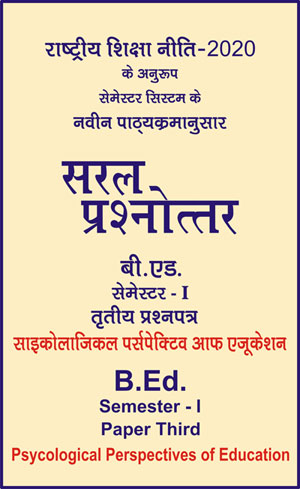|
बी एड - एम एड >> बी.एड. सेमेस्टर-1 प्रश्नपत्र-III - साइकोलाजिकल पर्सपेक्टिव आफ एजूकेशन बी.एड. सेमेस्टर-1 प्रश्नपत्र-III - साइकोलाजिकल पर्सपेक्टिव आफ एजूकेशनसरल प्रश्नोत्तर समूह
|
5 पाठक हैं |
|||||||
बी.एड. सेमेस्टर-1 प्रश्नपत्र-III - साइकोलाजिकल पर्सपेक्टिव आफ एजूकेशन (अंग्रेजी भाषा में)
Question- Describe Class-room techniques of motivation their functions and objectives.
Or
Which techniques would you adopt to motivate students?
Or
Describe the Techniques of Motivation.
Or
Describe the techniques of enhancing learner’s motivation.
Or
Describe the Function and Objectives of Classroom Motivation.
Answer-
Types of Classify Motives
(1) Innate Motives : An individual brings this type of motives from his birth. He can not live without these motives. They are biological as well as physical e.g. hunger thirst, step and rest etc.
(2) Psychological Motives : These are concerned with emotions of an individual e.g. fear, anger, love, pain and comfort etc.
(3) Acquired Motives : This type of motives are acquired from the environment according to his maturation, growth and development, e.g. interest habit, groups etc.
104 / B.Ed. (I Semester)
(4) Social Motives : These are attained from social values, social ideas, norms and situations, e.g. self-security, exhibition, curiosity etc.
(5) Natural Motives : These depend upon human nature, e.g. play, imitation, suggestion, respect etc.
(6) Artificial Motives : These are supplementary of natural motives e.g. punishment, reward, praise, co-operation and criticism etc.
Techniques of Motivation : Techniques of motivation can be broadly classified under three main heads-1. External motivation, 2. Internal motivation, 3. External and Internal motivation. The following are major techniques of motivation :
(1) Reward and Punishment,
(2) Praise and Re-proof,
(3) Success and Failure,
(4) Competition and Co-operation,
(5) Knowledge of Result or Progress,
(6) Novelty, and
(7) Level and Aspiration.
In addition of these techniques, attitudes, questions and audio-visual aids also provide motivation to the learner.
(1) Reward and Punishment : It is an important technique of motivation for classroom teaching-learning situation. The reward is given for good and correct work of the students. It is an external type of motivation. The students get encouragement for their work.
The punishment is an opposite technique of reward. These students are punished for their undersirable behaviour so that they would not repeat the same behaviour. In that way undersirable behaviour is restricted.
(2) Praise and Reproof : This is also an external motivation. The excellent work and correct behaviour are praised by the teacher so that the probability of desirable behaviour is increased. They get encouragement for their good performance.
The reproof or criticism of wrong work is also a technique of motivation. The proper use of this technique has the positive effect and undersirable behaviour probability may be reduced. This technique is most effective and useful for bright students and this should not be used for poor students. It should be used in a statement form.
(3) Success and Failure : Bernard says that success develops the self-confidence among learners. The success is most effective for average student, but it provides motivation to everyone.
The failure is an opposite to the success techniques. Sometimes failure functions as a motive whenever a learner accepts it as a challenge and gets force and reinforcement for his work. Its nature in external as well as internal.
(4) Competition and Cooperation : It is a social motivation, hence it is more useful in classroom teaching. We observe the feeling of competition and cooperation among the students in schools. One student intends to perform better than others. The teacher encourages the students by this technique.
(5) Knowledge of Result or Progress : The knowledge of progress satisfies the ego of a learner and accelerates the speed of the learning. There are various devices to employ the technique of motivation. The technique is mainly used in programmed instruction material. The learner has to confirm his own response when he finds that response is correct, he feels pleasure or happiness. In this way, his behaviour is reinforced for the next task. Generally in schools, the progress report is prepared for every student to provide the awareness about their knowledge of progress.
(6) Novelty : The learner has to adjust his own environment and novelty satisfies his need. The students get motivation by novelty and take more interest in new work. It is an essential in using this technique that new thing should be related to the old one or familiar things. The change and variation which is related to life situation is called the novelty. The proper use of this device encourages the student’s behaviour.
(7) Level of Aspiration : A person aspires to achieve a thing which is related to the goal of his life which is known as level of aspiration. The level of aspiration of an individual depends upon his past achievements and abilities. The person gets success in his life, if he fixes his level of aspiration considering the reality of his life. The level of aspiration depends upon the previous achievement of a person. It is a form of motivation. The main task of a teacher is to raise the level of aspiration of his students.
Function of Classroom Motivation
- It organizes the behaviour of the students.
- It initiates and sustains the activities and behaviour of the learners.
- It regulates and controls the students behaviours.
- It accelerates the rate of activities and behaviour of the student.
Objectives of Classroom Motivation
- Describe change in pupil’s behaviour.
- Character building of the students.
- Active and attentive response of the learners.
- Mental development.
- Development of interest.
- Development of social efficiency and traits.
- Raising the level of attainment, and level of aspiration.
- Development of feeling of discipline.
- Facilitate an individual variation in learning situation.
|
|||||














